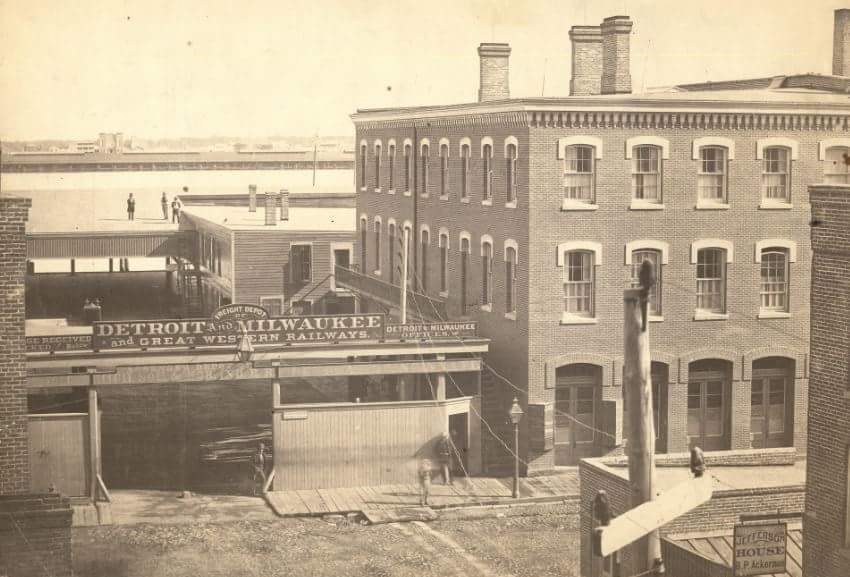Wood covered Wades servicing the D&M depot in downtown Detroit CA. 1860
By Nathan Smack; posted January 20, 2016
View Original: Click to zoom, then click to magnify (850 x 577) 61KB

|
Copied from Facebook. Curtis Erickson shared Peter Dudly's post in the Early Telegraph Insulators group: A c. 1860 photo shows Detroit & Milwaukee Depot from the foot of Beaubien Street. The station handled Detroit & Milwaukee Railway, Great Western Railway, and Michigan Southern & Northern Indiana Railroad passengers and freight. Before May 1852, when this terminal opened, Detroit and Pontiac Railroad (later Detroit & Milwaukee Railway) trains terminated in the middle of De Quindre Road, just north of Gratiot Avenue, near today's Eastern Market. I've seen mention of a stub-ended terminal, located (as of May 19, 1838) on the north side of either Jefferson Avenue or Larned Street, but I can't confirm that. If such a station ever existed, any remaining archaeological evidence was removed when Grand Trunk Western Railroad's Dequindre Cut was excavated during the 1920s. On July 4, 1843, Detroiters celebrated the completion of the railroad between Pontiac, Michigan and Detroit – thirteen years after the project had first been authorized by Michigan's territorial legislature. D&P RR had been denied permission to cross Jefferson Avenue (Detroit's main street at the time), so trains began running through the center of Gratiot Avenue, between De Quindre Road and Farmer Street. These street-running trains were extremely unpopular among nearby merchants and residents. Imagine smoke-belching steam locomotives chugging through the middle of Gratiot, which was not yet paved – when it rained, passing trains compressed the crossties, spraying mud everywhere. In any weather, it was difficult for horse-drawn wagons and carriages to cross the track. When a train went through, most nearby horses panicked. Eventually, Detroit's Common Council passed an ordinance, requiring the railroad to remove its rails from Gratiot Avenue – the railroad ignored the law. Irate Detroiters soon intervened. On December 12, 1849, "a number of men armed with crow-bars proceeded to a locality near the head of Beaubien Street (at Gratiot Avenue) and tore up several rods of D&P RR. When the train arrived from Pontiac, there was no place to turn the engine – it had to back up to Royal Oak. Twelve men were arrested, but public sympathy was with them and they were released, as it was conclusively proven that the railroad was a nuisance and that, in the destruction of the railroad, the aggressors were merely carrying out the will of the Council as publicly expressed. For a long time, the cars stopped at Dequindre Street. The old track was however, re-laid." On February 11, 1850, the track along Gratiot Avenue was torn up again, east of Randolph Street. In July, D&P RR "asked permission of the Common Council to regain the use of Gratiot Avenue; a resolution to that effect was passed. Following this authority, the road was extended through Campus Martius." Another new D&P Depot was built on the future site of the first Detroit Opera House, near Campus Martius. This was about three years after Michigan Central Railroad abandoned its "midtown" station, located along the southern edge of Michigan Avenue, between Woodward Avenue and Griswold Street, in favor of a new terminal on Third Street, near the riverfront. Within two years, the last steam train departed from Campus Martius when an even-newer depot at Brush and Atwater Streets opened May 31, 1852 (see photo). On April 26, 1866, a fire erupted aboard a railroad car ferry docked nearby, and soon spread to the fourteen-year-old station, which was destroyed. There were many injuries and fatalities. A new Brush Street Station was completed at the same location in 1867. Passengers of a dozen railroads arrived at the southeast corner of Brush and Atwater Streets during a dozen decades. Timetable-northbound MS&NI RR (later Lake Shore and Michigan Southern Railway) trains from Toledo actually traveled south-southeast from Lake Shore Junction (near Ferry Street), and then west-southwest from Dequindre Street, to get there. After 106 years, Brush Street Station was demolished in 1973, to make way for Renaissance Center – Burton Historical Collection photo, retrieved from Detroit Public Library. Information about street running on Gratiot Avenue was quoted (sort of) from History of Detroit, a chronicle of its progress, its industries, its institutions, and the people of the fair City of the straits, by Paul Leake (1912). |